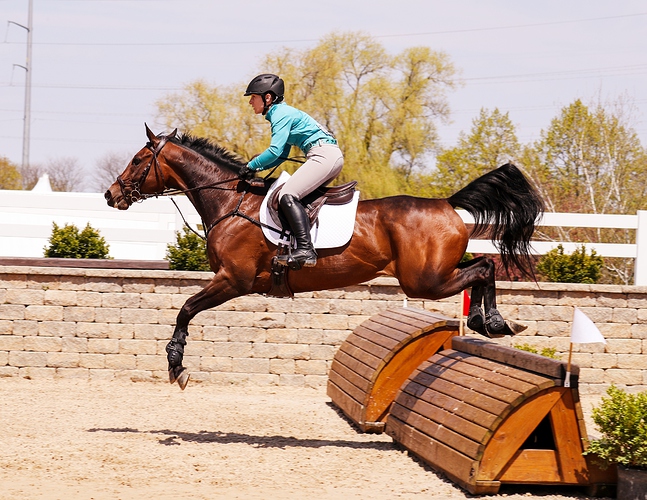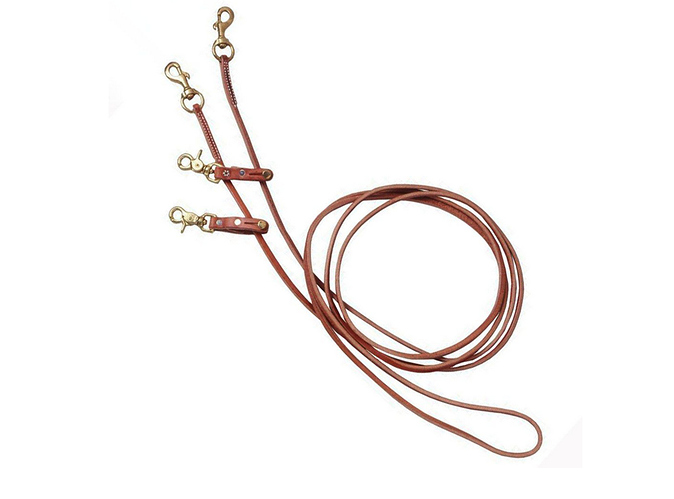Well, that’s what they turned to when I said what I said, roasting a picture of me riding my late mare in a Waterford on the snaffle ring, and calling me fat. Nice people! Here’s the picture.
Regardless of the device’s name or the rider in the video or her trainer, I fail to see how this device would contribute to the engagement of the hindquarters.
I am fairly certain it is just a plain leather draw rein. Probably the western leather draw rein variety. They are often sold in 5/8 or 3/8 rawhide, and not too long.
The sliders in these things are detachable, not all are sold with them.
I sold a pair not too long ago that look just like the OP’s photo. It would be easy to convert it into what is in OP’s photo with a flash keeper.
Some alteration would still have to be done to make it this tight though. This horse has no reprieve from it - there’s no way it could be used as draw reins at its current length.
Do they sell split draw reins? One rein might be able to be bastardized into this.
The color is also weird to me, I’ve always seen thin leather draw reins, especially western ones, in natural color. Maybe he dyed it? Seems like a lot of effort for a junk training tool.
Heavy oil, dark oil, etc would be that color. And they tend to darken a lot with use. https://gearuptackandapparel.com/collections/reins/products/ranch-heavy-oil-draw-rein
You could just have a clip end round roping rein.
Oh yup, that would do it. Sickening to me.
I don’t know if you’d need to modify anything. Western drawn reins are shorter than traditional english ones, and I’ve seen people loop the reins back on themselves through the girth.
I just sold the pair I had because they were too short for my horses over 16h. Because they’re made for QHs, not modern WBs with long necks. I could very easily see a pair being used exactly as in that photo with no modification.
Western draw reins are usually rawhide and they will darken plenty with leather care/conditioning. Mine were almost havana brown when I sold them.
I actually don’t agree entirely, because lots of these modern quarter horses are absolutely HUGE, well into the 17hh.
Maybe if they were made for the reiners and cutters, yes, but even the WP qhs are trending towards giants.
Nevertheless, the equipment hasn’t changed all that much…
I still want to know what the thinking is behind applying the pressure to the nasal bone instead of the poll or the bit. Assuming there was thinking behind it.
I assume it is to prevent the horse from lifting its head and coming out of forced flexion - and likely because the rider lacks the ability to keep the horse flexed, round, on the bit without keeping a death grip on its mouth. (And for the contrarian - when I say “the rider,” I am thinking of ANY rider who uses this type of device.)
And thinking of it biomechanically, it probably also keeps the horse from getting too big in its gaits (again, generic “rider”). IOW, the horse goes from being a back mover to being a leg mover which enables the rider to better sit the trot. AND it prevents the horse from throwing its head up or out and flattening out and running…
I am still interested to know if the device has an actual name. It is not a chambon, not a de gogue, not a western bosal, not a German martingale, not draw reins, not side reins, not Vienna reins, not any training aid I have ever seen in my 50-odd years with horses.



Absolutely contrary to the purposes of dressage and good horsemanship.
I meant to also say the lower part of the nasal bone is a sensitive area because it is somewhat fragile - much more fragile than the poll or the jawbone. Of course the mouth and gums are also sensitive but the jawbone is stronger and tougher and it takes a fair amount of force or torque to break it - but not so with the nasal bone. While fractures there are not common, it is also true that the horse tries to protect that area and that good horsemen (generic) do not put unrelenting pressure on that part of the nasal bone. Even a chain over the nose offers release - this contraption never offers release.
Well it does, when the horse sucks back and stays there. Doesn’t sound very dressagey to me.
Does this horse not get a stretchy walk break for the entire ride? Do people who ride in side reins not give their horses stretchy walk breaks either?
Speaking of walk - I can think of no device that will ruin a walk faster.
Lovely mare. Please send me your solid lower leg post haste.
I have never been slammed by my instructor as hard as she slammed me when I allowed my horse to be a leg mover.
Exactly, the amount of release it offers is directly related to how it is adjusted. This does not imply it is a useful piece of equipment in training, but the only way it will not offer release is if it is adjusted tighter than the horse can actually flex, tight enough that the release point is at rollkeur (just moves the pain to a different point) or it’s majikal leather that continually tightens no matter how much the horse yields. The tiny fragment of the pic appears pretty tight, but there could be other instances where it’s very loose. You know, like side reins. They are adjustable.
That’s so obviously a separate argument from whether it’s a useful tool that it shouldn’t need to be pointed out, but this is COTH, so I’ll state the obvious: saying it’s adjustable is not the same as saying it’s useful or appropriate.
As for what its f*cking name is, that horse has been beat to death twice by now. NOBODY KNOWS, PICK YER OWN NAME FOR IT.
And in the video it’s not preventing the horse from rushing. It needs to be tighter. /S
The Thing runs through the bit, though I’d have to rig one up (not!) to figure out the action it would have, but I suspect it has some effect on the mouth.


